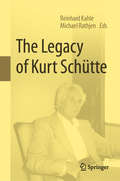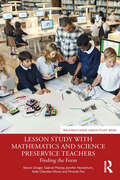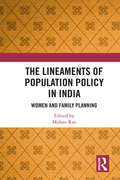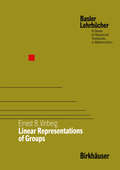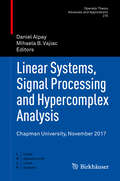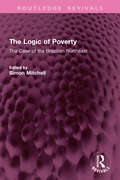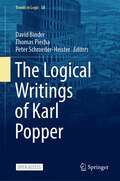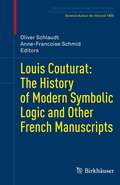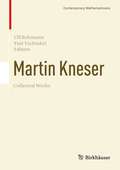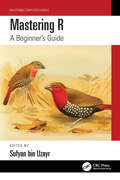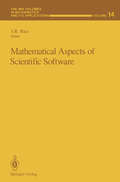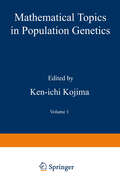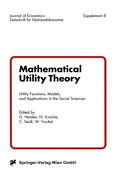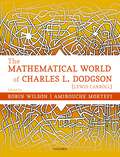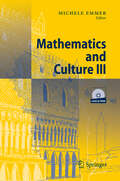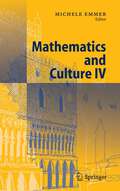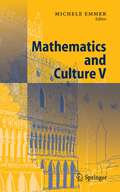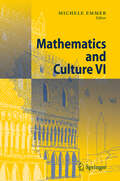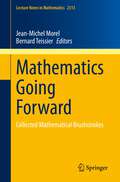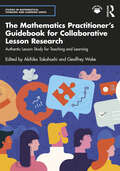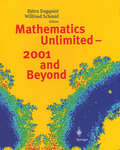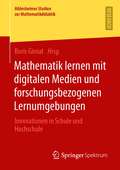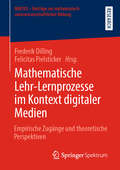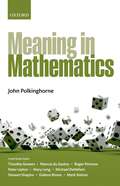- Table View
- List View
The Legacy of Kurt Schütte
This book on proof theory centers around the legacy of Kurt Schütte and its current impact on the subject. Schütte was the last doctoral student of David Hilbert who was the first to see that proofs can be viewed as structured mathematical objects amenable to investigation by mathematical methods (metamathematics). Schütte inaugurated the important paradigm shift from finite proofs to infinite proofs and developed the mathematical tools for their analysis. Infinitary proof theory flourished in his hands in the 1960s, culminating in the famous bound Γ0 for the limit of predicative mathematics (a fame shared with Feferman). Later his interests shifted to developing infinite proof calculi for impredicative theories. Schütte had a keen interest in advancing ordinal analysis to ever stronger theories and was still working on some of the strongest systems in his eighties. The articles in this volume from leading experts close to his research, show the enduring influence of his work in modern proof theory. They range from eye witness accounts of his scientific life to developments at the current research frontier, including papers by Schütte himself that have never been published before.
Lesson Study with Mathematics and Science Preservice Teachers: Finding the Form (WALS-Routledge Lesson Study Series)
This insightful volume offers an overview of the fundamentals of lesson student practice in US teacher education as well as examples from math and science teacher educators using lesson study in their local contexts. The number of teacher educators using lesson study with preservice teachers is small but growing. This book is aimed at teacher educators who may want to try lesson study in university contexts without the challenge of translating the practice from the K-12 context on their own. In this volume, lesson study is broadly overviewed, attention is given to its constituent steps, and examples of lesson study in preservice contexts are shared. Given the broad array of teacher education program designs, numerous contingencies guide teacher educators in their implementation of lesson study, given their contextual affordances and limitations. The lesson study descriptions and cases in this book will support teacher educators and scholars across subject specialities and geographic lines, as they seek instructional frameworks to advance their pedagogical goals.
The Lineaments of Population Policy in India: Women and Family Planning
India is the first country in the world to have an official programme for family planning that commenced in 1952. It has also seen a strong women’s movement to assert reproductive and contraceptive rights. This book brings to the fore several contestations and negotiations between public policy and the women’s movement in India. The comprehensive volume puts together key documents from archival records and authoritative sources, and traces the contours that have marked and defined the population policy in India as well as rights issues for women. A major intervention in the field, this book will be indispensable for scholars and researchers in public policy, public health, demography, gender studies, social policy, development studies, sociology, social justice, human rights, politics and those interested in the study of modern India.
Linear Representations of Groups (Birkhäuser Advanced Texts Basler Lehrbücher)
This book gives an exposition of the fundamentals of the theory of linear representations of finite and compact groups, as well as elements of the the ory of linear representations of Lie groups. As an application we derive the Laplace spherical functions. The book is based on lectures that I delivered in the framework of the experimental program at the Mathematics-Mechanics Faculty of Moscow State University and at the Faculty of Professional Skill Improvement. My aim has been to give as simple and detailed an account as possible of the problems considered. The book therefore makes no claim to completeness. Also, it can in no way give a representative picture of the modern state of the field under study as does, for example, the monograph of A. A. Kirillov [3]. For a more complete acquaintance with the theory of representations of finite groups we recommend the book of C. W. Curtis and I. Reiner [2], and for the theory of representations of Lie groups, that of M. A. Naimark [6]. Introduction The theory of linear representations of groups is one of the most widely ap plied branches of algebra. Practically every time that groups are encountered, their linear representations play an important role. In the theory of groups itself, linear representations are an irreplaceable source of examples and a tool for investigating groups. In the introduction we discuss some examples and en route we introduce a number of notions of representation theory. O.
Linear Systems, Signal Processing and Hypercomplex Analysis: Chapman University, November 2017 (Operator Theory: Advances and Applications #275)
This volume includes contributions originating from a conference held at Chapman University during November 14-19, 2017. It presents original research by experts in signal processing, linear systems, operator theory, complex and hypercomplex analysis and related topics.
The Logic of Poverty: The Case of the Brazilian Northeast (Routledge Revivals)
First published in 1981, The Logic of Poverty consists of eight essays that share at least one assumption: that Northeast Brazil provides a startling example of inhumane economic development. The contributors have all worked in the area, and know it at first hand. They look at rural structure and the role of the unemployed ‘reserve army’, the state of the sugar industry, the ineffectiveness of the irrigation schemes, the stagnation in the fishing sector, the lack of credit available to peasants and the role of SUDENE, the first development agency in the region. Together they paint a picture of poverty and of the factors that allow it to continue, and they place that poverty in the context of the wider economy of Brazil, relating it to the extraordinary transformation that has been called ‘the Brazilian miracle’. This book will be of interest to students of geography, anthropology, economics and sociology.
The Logical Writings of Karl Popper (Trends in Logic #58)
This open access book is the first ever collection of Karl Popper's writings on deductive logic.Karl R. Popper (1902-1994) was one of the most influential philosophers of the 20th century. His philosophy of science ("falsificationism") and his social and political philosophy ("open society") have been widely discussed way beyond academic philosophy. What is not so well known is that Popper also produced a considerable work on the foundations of deductive logic, most of it published at the end of the 1940s as articles at scattered places. This little-known work deserves to be known better, as it is highly significant for modern proof-theoretic semantics.This collection assembles Popper's published writings on deductive logic in a single volume, together with all reviews of these papers. It also contains a large amount of unpublished material from the Popper Archives, including Popper's correspondence related to deductive logic and manuscripts that were (almost) finished, but did not reach the publication stage. All of these items are critically edited with additional comments by the editors. A general introduction puts Popper's work into the context of current discussions on the foundations of logic. This book should be of interest to logicians, philosophers, and anybody concerned with Popper's work.
Louis Couturat: The History of Modern Symbolic Logic and Other French Manuscripts (Publications des Archives Henri Poincaré Publications of the Henri Poincaré Archives)
This volume features a critical edition of the recently rediscovered manuscripts written by the French philosopher Louis Couturat (1868-1914). It includes the transcriptions of three of his believed to be lost manuscripts: first the “Cours de Caen: 1898-99” on various systems of symbolic logic, second his lecture at the Collège de France “Histoire de la logique formelle moderne", and third his textbook on mathematical logic. The manuscripts document the early reception of mathematical logic in France and provide insights into the first introduction of the French reader to the work of Gottlob Frege and Bertrand Russell. It is the aim of the editors of this volume to contribute to the history of symbolic logic, particularly the history of its dissemination and its teaching in France. At the same time, the volume contributes to an alternative history and conception of philosophy in which semiotics and concrete mathematical practice stand in focus. The book is interesting for students and researchers in the history of philosophy, mathematics, and logic.
Martin Kneser Collected Works (Contemporary Mathematicians)
This volume presents the collection of mathematical articles by Martin Kneser, reprinted in the original language – mostly German –, including one yet unpublished. Moreover, also included is an article by Raman Parimala, discussing Kneser’s work concerning algebraic groups and the Hasse principle, which has been written especially for this volume, as well as an article by Rudolf Scharlau about Kneser’s work on quadratic forms, published elsewhere before. Another commentary article, written by Günter M. Ziegler especially for this volume, describes the astounding influence on the field of combinatorics of what was published as “Aufgabe 360” and its subsequent solution in 1955 resp. 1957 in the “Jahresbericht der Deutschen Mathematiker-Vereinigung”. However, as the titles of the articles show, Kneser’s mathematical interests were much broader, which is beautifully discussed in an obituary by Ulrich Stuhler, included as well in this volume.
Mastering R: A Beginner's Guide (Mastering Computer Science)
R is a statistical computing and graphics programming language that you can use to clean, analyze, and graph data. It is widely used by researchers from various disciplines to estimate and display results and by teachers of statistics and research methods. This book is a detailed guide for beginners to understand R with an explanation of core statistical and research ideas. One of the powerful characteristics of R is that it is open-source, which means that anyone can access the underlying code used to run the program and add their own code for free. It will always be able to perform the latest statistical analyses as soon as anyone thinks of them. R corrects mistakes quickly and transparently and has put together a community of programming and statistical experts that you can turn to for help. Mastering R: A Beginner’s Guide not only explains how to program but also how to use R for visualization and modeling. The fundamental principles of R explained here are helpful to beginner and intermediate users interested in learning this highly technological and diverse language.
Mathematical Aspects of Scientific Software (The IMA Volumes in Mathematics and its Applications #14)
Since scientific software is the fuel that drives today's computers to solve a vast range of problems, huge efforts are being put into the development of new software, systems and algorithms for scientific problem solving. This book explores how scientific software impacts the structure of mathematics, how it creates new subfields, and how new classes of mathematical problems arise. The focus is on five topics where the impact is currently being felt and where important new challenges exist, namely: the new subfield of parallel and geometric computations, the emergence of symbolic computation systems into "general" use, the potential emergence of new, high-level mathematical systems, and the crucial question of how to measure the performance of mathematical problem solving tools.
Mathematical Sciences and Applications: Proceedings of the International Conference on Mathematical Sciences and Applications (ICMSA 2023)
The papers appearing in these proceedings are part of talks, oral presentations and poster presentations given at the International Conference on Mathematical Sciences and Applications held in the Department of Mathematics, Dr. Bhimrao Ambedkar University, Agra (India) from March 24-26, 2023. The Conference was held under the auspices of the Mathematics Department which is recognized and founded by the U.P. State Govt. as a Centre of Excellence in Mathematics. The aim of the conference was to have a gathering of experts from the different field of Mathematical sciences and its applications in physical and biological sciences.
Mathematical Topics in Population Genetics (Biomathematics #1)
A basic method of analyzing particulate gene systems is the proba bilistic and statistical analyses. Mendel himself could not escape from an application of elementary probability analysis although he might have been unaware of this fact. Even Galtonian geneticists in the late 1800's and the early 1900's pursued problems of heredity by means of mathe matics and mathematical statistics. They failed to find the principles of heredity, but succeeded to establish an interdisciplinary area between mathematics and biology, which we call now Biometrics, Biometry, or Applied Statistics. A monumental work in the field of popUlation genetics was published by the late R. A. Fisher, who analyzed "the correlation among relatives" based on Mendelian gene theory (1918). This theoretical analysis over came "so-called blending inheritance" theory, and the orientation of Galtonian explanations for correlations among relatives for quantitative traits rapidly changed. We must not forget the experimental works of Johanson (1909) and Nilsson-Ehle (1909) which supported Mendelian gene theory. However, a large scale experiment for a test of segregation and linkage of Mendelian genes affecting quantitative traits was, prob ably for the first time, conducted by K. Mather and his associates and Panse in the 1940's.
Mathematical Utility Theory: Utility Functions, Models, and Applications in the Social Sciences (Journal of Economics Zeitschrift für Nationalökonomie Supplementum #8)
This proceedings volume of an international conference which took place in Essen in October 1997 brings together economists, mathematicians, and psychologists. Their contributions represent new research in the field of mathematical utility theory with an emphasis on its applications in the social sciences. Readers of this volume can inform themselves about novel results in mathematical utility theory and their significance for the social sciences. The contributions cover a spectrum of fields from topological methods in utility theory to the application of experimental methods to utility theory.
The Mathematical World of Charles L. Dodgson (Lewis Carroll)
Charles Lutwidge Dodgson is best known for his 'Alice' books, Alice's Adventures in Wonderland and Through the Looking-Glass, written under his pen name of Lewis Carroll. Yet, whilst lauded for his work in children's fiction and his pioneering work in the world of Victorian photography, his everyday job was a lecturer in Mathematics at Christ Church, Oxford University. The Mathematical World of Charles L. Dodgson (Lewis Carroll) explores the academic background behind this complex individual, outlining his mathematical life, describing his writings in geometry, algebra, logic, the theory of voting, and recreational mathematics, before going on to discuss his mathematical legacy. This is the first academic work that collects the research on Dodgson's wide-ranging mathematical achievements into a single practical volume. Much material appears here for the first time, such as Dodgson's personal letters and drawings, as well as the results of recent investigations into the life and work of Dodgson. Complementing this are many illustrations, both historical and explanatory, as well as a full mathematical bibliography of Dodgson's mathematical publications.
Mathematics and Culture III
This work contains the proceedings of the "Mathematics and Culture" conference held in Venice in March 2002. The conference aims to act as a bridge across the various aspects of human knowledge. While keeping mathematics as its core, it is aimed at anyone endowed with cultural curiosity and interests, whether within or (even more so) outside mathematics. This volume therefore covers music, cinema, art, theatre and literature, with topics ranging from Tibet to comics.
Mathematics and Culture IV
Gaudi’s dream which will be reached finalizing the construction of the "Sagrada Familia" in Barcelona, the victory of the Swiss sail boat "Alinghi", which won America’s Cup, films such as " A Beautiful Mind" and "Enigma", the theatrical play based on the life of Galois, the images of the Dutch graphic artist M. C. Escher, crypotography, comics. What all these topics have in common? Mathematics, of course. This book focuses on the important role of mathematics in culture. It shows how very complex links between mathematics and culture can be not only interesting and stimulating but also fun.
Mathematics and Culture V
“I mean the third”cried the old man taking up the geometry book. “Well, young lady…”and he bent over his daughter. The princess gazed with terror into her father's keen eyes. He, on his part, got angry – pushed away his chair, dragged it back with a cl- ter – trying all the while to control himself; then again he would break out and storm, and wish the whole thing to the devil. As ill-luck would have it, to-day again his daughter answered at random and wrongly. “What an idiot!”he exclaimed, flinging down the book. The he rose, walked up and down, came back and stroked his daughter's hair, sat down again, and began his explanation once more. “It does not do, princess, it does not do”, he said, seeing her rise to leave him with VII the book in her hand. “Mathematics is a noble science, and I do not want you to be just like all the silly young ladies one meets. Persevere and you will learn to like the work, and the dullness will be nocked out of your brain. ” These words were spoken by Prince Andrei Bolkonskij, who was talking to Princess Marja Bolokonskaja, his daughter. They are two of the protagonists of Lev Tolstoy’s War and Peace, finished in 1869.
Mathematics Going Forward: Collected Mathematical Brushstrokes (Lecture Notes in Mathematics #2313)
This volume is an original collection of articles by 44 leading mathematicians on the theme of the future of the discipline. The contributions range from musings on the future of specific fields, to analyses of the history of the discipline, to discussions of open problems and conjectures, including first solutions of unresolved problems. Interestingly, the topics do not cover all of mathematics, but only those deemed most worthy to reflect on for future generations. These topics encompass the most active parts of pure and applied mathematics, including algebraic geometry, probability, logic, optimization, finance, topology, partial differential equations, category theory, number theory, differential geometry, dynamical systems, artificial intelligence, theory of groups, mathematical physics and statistics.
The Mathematics Practitioner’s Guidebook for Collaborative Lesson Research: Authentic Lesson Study for Teaching and Learning (Studies in Mathematical Thinking and Learning Series)
This resource provides mathematics educators with tools for conducting Collaborative Lesson Research (CLR), a form of Lesson Study developed out of the original Japanese Lesson Study and intended to improve student and teacher learning. Renowned mathematics education researchers Akihiko Takahashi and Geoffrey Wake bring together educators across the US and UK with first-hand experience using CLR in their schools. Readers will learn the essentials for an impactful Lesson Study directly from the scholars who coined the term, and benefit from the dual perspectives of math education researchers and teachers who have used CLR when reflecting on their own classroom pedagogy. These contributors define CLR and provide examples of successful CLR using real-life case studies, as well as introducing pathways for getting started and practical suggestions for implementation into different school environments. Across these examples, readers will: understand the essence of Lesson Study, considered as CLR, and its important features be advised what participants in CLR should expect to do (observing research lessons, designing lessons, teaching research lessons, facilitating post-lesson discussion, etc.) and provide guidance and support with this enactment be advised on how to develop, embed, and sustain CLR communities preview potential outcomes over time from undertaking CLR Research lesson proposals and plans to support readers in understanding CLR are also included. Ideal for practicing teachers, teacher leaders, teacher educators, and professional developers involved in mathematics teaching, this book offers first-of-its-kind entry points for CLR. Its combination of theory and practice will empower educators to implement this increasingly popular vehicle for understanding students’ learning of mathematics.
Mathematics Unlimited - 2001 and Beyond
This is a book guaranteed to delight the reader. It not only depicts the state of mathematics at the end of the century, but is also full of remarkable insights into its future de- velopment as we enter a new millennium. True to its title, the book extends beyond the spectrum of mathematics to in- clude contributions from other related sciences. You will enjoy reading the many stimulating contributions and gain insights into the astounding progress of mathematics and the perspectives for its future. One of the editors, Björn Eng- quist, is a world-renowned researcher in computational sci- ence and engineering. The second editor, Wilfried Schmid, is a distinguished mathematician at Harvard University. Likewi- se the authors are all foremost mathematicians and scien- tists, and their biographies and photographs appear at the end of the book. Unique in both form and content, this is a "must-read" for every mathematician and scientist and, in particular, for graduates still choosing their specialty. Limited collector's edition - an exclusive and timeless work. This special, numbered edition will be available until June 1, 2000. Firm orders only.
Mathematik lernen mit digitalen Medien und forschungsbezogenen Lernumgebungen: Innovationen in Schule und Hochschule (Hildesheimer Studien zur Mathematikdidaktik)
Entdeckendes Lernen und digitale Medien in Schule und Hochschule stehen im Zentrum dieses Sammelbandes: Anhand konkret ausgearbeiteter Konzepte und Aufgabensammlungen wird vorgestellt, wie dynamische Geometriesysteme und Tabellenkalkulationen im Geometrieunterricht der Sekundarstufe ebenso eingesetzt werden können wie in universitären Seminaren. Forschungsbasiertes Lernen mit oder ohne digitale Medien wird an mathematischen Themen wie der Analysis und der Graphentheorie (von der Grundschule bis zur Universität) oder an gebietsübergreifenden Fallstudien (wie am Spiel „Lights out“) oder als allgemeines Konzept für Seminare zum Grundschullehramt veranschaulicht. Außerdem werden digitale Lern- und Prüfungsumgebungen für den fachwissenschaftlichen und fachdidaktischen Teil der mathematischen Lehramtsausbildung vorgestellt.
Mathematische Lehr-Lernprozesse im Kontext digitaler Medien: Empirische Zugänge und theoretische Perspektiven (MINTUS – Beiträge zur mathematisch-naturwissenschaftlichen Bildung)
Der vorliegenden Band zeichnet sich durch eine große Bandbreite an Zugängen zum Themenkomplex „Digitales im Mathematikunterricht“ aus; diese reicht von Theorieartikeln zur Fundierung des Einsatzes digitaler Werkzeuge und Medien in der Mathematikdidaktik, über Anwendungsperspektiven für die Mathematiklehrerinnen- und Mathematiklehrerausbildung, bis hin zu aussagekräftigen Praxisberichten aus der Schule. Das nun entstandene Werk ist Ausdruck einer lebendigen multiperspektivischen Auseinandersetzung mit dem Gegenstand der digitalen Bildung in der Mathematikdidaktik. Diese wird im vorliegenden Buch getragen von einer positiven Grundeinstellung zu den Möglichkeiten, die digitale Werkzeuge und Medien für den Mathematikunterricht entfalten können, werden aber in kritischer Abwägung wissenschaftlich betrachtet um auszuloten wann, wo und wie ein Einsatz einen fachinhaltlichen und fachdidaktischen Mehrwert entfalten kann.
Meaning in Mathematics
Is mathematics a highly sophisticated intellectual game in which the adepts display their skill by tackling invented problems, or are mathematicians engaged in acts of discovery as they explore an independent realm of mathematical reality? Why does this seemingly abstract discipline provide the key to unlocking the deep secrets of the physical universe? How one answers these questions will significantly influence metaphysical thinking about reality. This book is intended to fill a gap between popular 'wonders of mathematics' books and the technical writings of the philosophers of mathematics. The chapters are written by some of the world's finest mathematicians, mathematical physicists and philosophers of mathematics, each giving their perspective on this fascinating debate. Every chapter is followed by a short response from another member of the author team, reinforcing the main theme and raising further questions. Accessible to anyone interested in what mathematics really means, and useful for mathematicians and philosophers of science at all levels, Meaning in Mathematics offers deep new insights into a subject many people take for granted.
